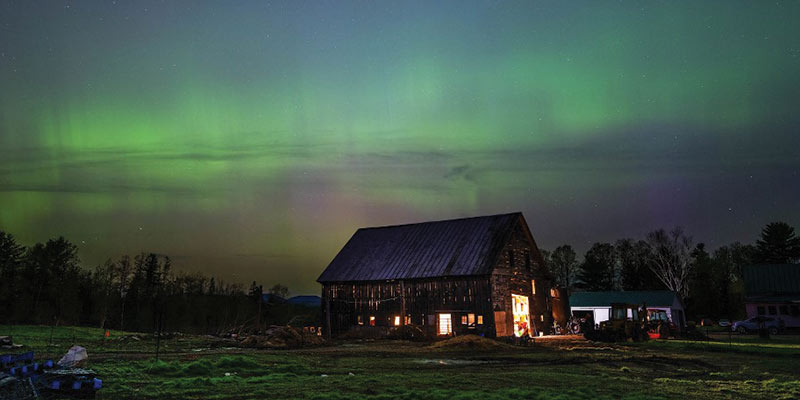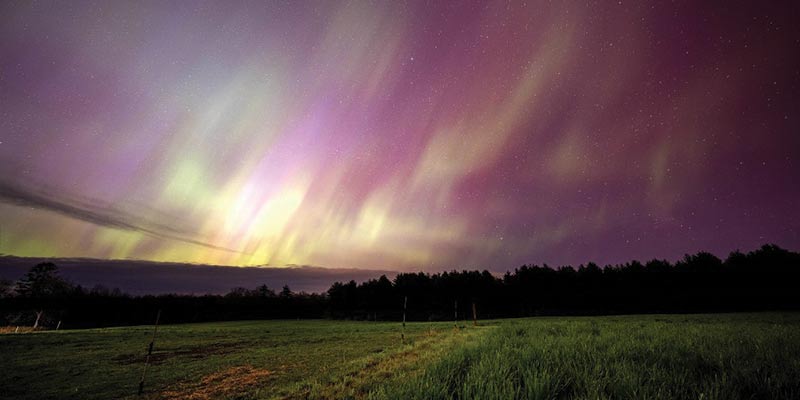- World
- May 13
Explainer - Northern Lights or Aurora Borealis
• The biggest geomagnetic storm in two decades, sparked by solar flares, put on an amazing skyward light show across the globe.
• It has caused only minor disruptions to the electric power grid, communications and satellite positioning systems.
• Brilliant purple, green, yellow and pink hues of the Northern Lights were reported worldwide, with sightings in Germany, Switzerland, London, Prague, Barcelona and elsewhere.
• In the US, the solar storm pushed the lights much further south than normal.
• In Mexicali, a desert city on Mexico’s northern border thousands of miles from the Arctic region, gradients of pink and purple illuminated the night sky.
What is a geomagnetic storm?
• A geomagnetic storm is a major disturbance of Earth’s magnetosphere that occurs when there is a very efficient exchange of energy from the solar wind into the space environment surrounding Earth.
• These storms result from variations in the solar wind that produce major changes in the currents, plasmas, and fields in Earth’s magnetosphere.
• The solar wind conditions that are effective for creating geomagnetic storms are sustained periods of high-speed solar wind, and most importantly, a southward directed solar wind magnetic field (opposite the direction of Earth’s field) at the dayside of the magnetosphere.
• This condition is effective for transferring energy from the solar wind into Earth’s magnetosphere.
• The largest storms that result from these conditions are associated with solar coronal mass ejections (CMEs), where a billion tonnes or so of plasma from the Sun, with its embedded magnetic field, arrives at Earth.
• CMEs typically take several days to arrive at Earth, but have been observed, for some of the most intense storms, to arrive in as short as 18 hours.
• Solar flares, coronal mass ejections, high-speed solar wind, and solar energetic particles are all forms of solar activity. All solar activities are driven by the solar magnetic field.
Does solar activity affect Earth?
• Modern society depends on a variety of technologies susceptible to the extremes of space weather. Changes in the ionosphere during geomagnetic storms interfere with high-frequency radio communications and Global Positioning System (GPS) navigation.
• During polar cap absorption events caused by solar protons, radio communications can be compromised for commercial airliners on transpolar crossing routes.
• Exposure of spacecraft to energetic particles during solar energetic particle events and radiation belt enhancements cause temporary operational anomalies, damage critical electronics, degrade solar arrays, and blind optical systems such as imagers and star trackers.
• Human and robotic explorers across the solar system are also affected by solar activity. Research has shown, in a worst-case scenario, astronauts exposed to solar particle radiation can reach their permissible exposure limits within hours of the onset of an event. Surface-to-orbit and surface-to-surface communications are sensitive to space weather storms.
• An extreme geomagnetic storm in 2003, for example, took out power in Sweden and damaged power transformers in South Africa.
What is the Carrington Event?
• The Carrington Event in 1859 is the largest known example of a geomagnetic storm. The great geomagnetic storm of August 28 through September 3, 1859 was a famous space weather event.
• Auroral displays spanned several continents and were observed around the world during those days.
• Richard Carrington, a British astronomer, recorded the solar outburst, a white-light flare. Across the world, telegraph networks experienced disruptions and outages as a result of the currents generated by the geomagnetic storm.
What is aurora?
• The aurora is a spectacular natural phenomenon occurring in the Earth’s upper atmosphere, associated with powerful emissions from the Sun and geomagnetic disturbances.
• Auroras are caused by high energy charged particles from the Sun, such as electrons, entering the magnetosphere of the Earth.
• This is most likely to happen during a geomagnetic storm, resulting from the bombardment of the Earth by solar particles following a coronal mass ejection (CME).
• A CME often causes a major geomagnetic disturbance or storm which creates an opening for energetic particles streaming from the Sun to enter the Earth’s magnetosphere.
• In the wake of the CME impacting the Earth, in addition to the geomagnetic storm, the speed and density of the solar wind, the flow of particles outward from the Sun, is particularly high, enhancing the effect further.
• Once within the magnetosphere, the solar particles interact with the Earth’s magnetic field, spiralling around the field lines and following them towards the poles.
• Since the geomagnetic field lines converge toward the poles, the energetic particles also converge towards the poles and are also drawn downward into the ionosphere.
• In the ionosphere, they strike molecules and atoms of air at around 100 kilometres from the Earth’s surface (nitrogen and oxygen) causing them to radiate light.
• This light creates the beautiful colours of the aurora.
• Different gases give off different colours when they are heated. The same process is also taking place in the aurora.
• The two primary gases in the Earth’s atmosphere are nitrogen and oxygen, and these elements give off different colours during an aurora display.
• The green we see in the aurora is characteristic of oxygen, while hints of purple, blue or pink are caused by nitrogen.
• The aurora is also called the Northern Lights in the northern hemisphere and Southern Lights in the southern hemisphere.
• The technical term for the Northern Lights is Aurora Borealis and the Southern lights are called the Aurora Australis.
• The word Aurora was first used by Galileo and comes from Latin and is the name of the “Goddess of Dawn”.
• The word Borealis comes from the Latin word boreal which means “northern” or “from the north”.
• The word Australis is Latin for austral, which means “southern”.
Manorama Yearbook app is now available on Google Play Store and iOS App Store


